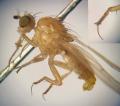Diptera.info :: Identification queries :: Fossils
Who is here? 2 guest(s)
|
Artificial process
|
|
| jorgemotalmeida |
Posted on 16-02-2009 02:34
|
|
Member Location: Viseu - PORTUGAL Posts: 9296 Joined: 05.06.06 |
Hi A friend of mine intends to capture a spider... and then make an incrustation of the spider in resine.. for example, using a syntethic resine (anything similar to the amber..). Anyone knows the proceduree for this task? ANy hints would be welcome. Thanks!  |
| Peter Macdonald |
Posted on 10-03-2009 14:23
|
|
Member Location: Posts: 12 Joined: 09.02.09 |
Hi, I have no direct personal experience of doing this, but have looked at very many pieces of amber with various fossil inclusions. The fossil record tells us that there are two problems to avoid. The first of these is water. All traces of water must be removed or else it will spoil the result. Many Baltic amber fossils have a this layer of an opaqe milky deposit around them. This seems to be caused by water from the fossil mixing with the resin from the tree. At very high magnifications, the milky substance appears to a froth of minute bubbles. The other common way that nature manages to spoil amber fossils is air bubbles, whether air that has been trapped directly in the amber or air which has been within the insect when it became trapped. I would imagine that resin should be very fluid if you are trying to embed an insect, so that it will flow through all of the hairs on the insect and thereby minimise the possibility of trapping any air in amongst the hairs. The resin which we now know as Baltic amber was very fluid when it seeped out of its tree. For example, it is possible to find undistorded pieces of spider's webs fossilised in amber, complete with the viscid droplets which the spider was hoping were going to try its lunch rather than themselves being trapped for eternity. To do this without distortion, the sap must have been very runny. See, for an example of a piece of web, the photo which I posted at http://www.dipter...d_id=19661. There is a piece of web running behind the fly from the muddle of the left hand side to the top of the photo. Some of the older and softer amber are often further embeded in epoxy for study. When that is being done, it is recommended that the embedding be done under vacuum so as to avoid air bubbles becomeing trapped. This may be worthwhile for the rare inclusions in the oder ambers i.e. pre tertiary) but may be overkill for a modern spider. For a general discussion on resin embedding, I found that the following link has an outlien of how to do it - http://www.breado...dding.html. Let us know how your friend gets on. Peter |
|
|
|
| Jump to Forum: |













